Building and Construction Industry Security of Payments Act: A Report
VerifiedAdded on 2023/06/04
|8
|2422
|293
Report
AI Summary
This report provides a comprehensive analysis of the Building and Construction Industry Security of Payments Act 1999 in New South Wales. It examines the Act's core operations, which focus on securing payments for contractors, subcontractors, and suppliers in the construction industry. The report details the objectives of the Act, emphasizing its role in protecting the rights of these parties to receive timely payments and addressing unfair trade practices. It also explores the regulations governing regular court actions related to payment disputes, highlighting the Act's impact on reducing litigation and streamlining the payment process. Furthermore, the report analyzes key amendments introduced to enhance the rights of subcontractors, including provisions for payment claims and trust accounts. The report concludes by emphasizing the Act's effectiveness in ensuring secure and timely payments within the construction sector.

BUILDING LAW
Paraphrase This Document
Need a fresh take? Get an instant paraphrase of this document with our AI Paraphraser
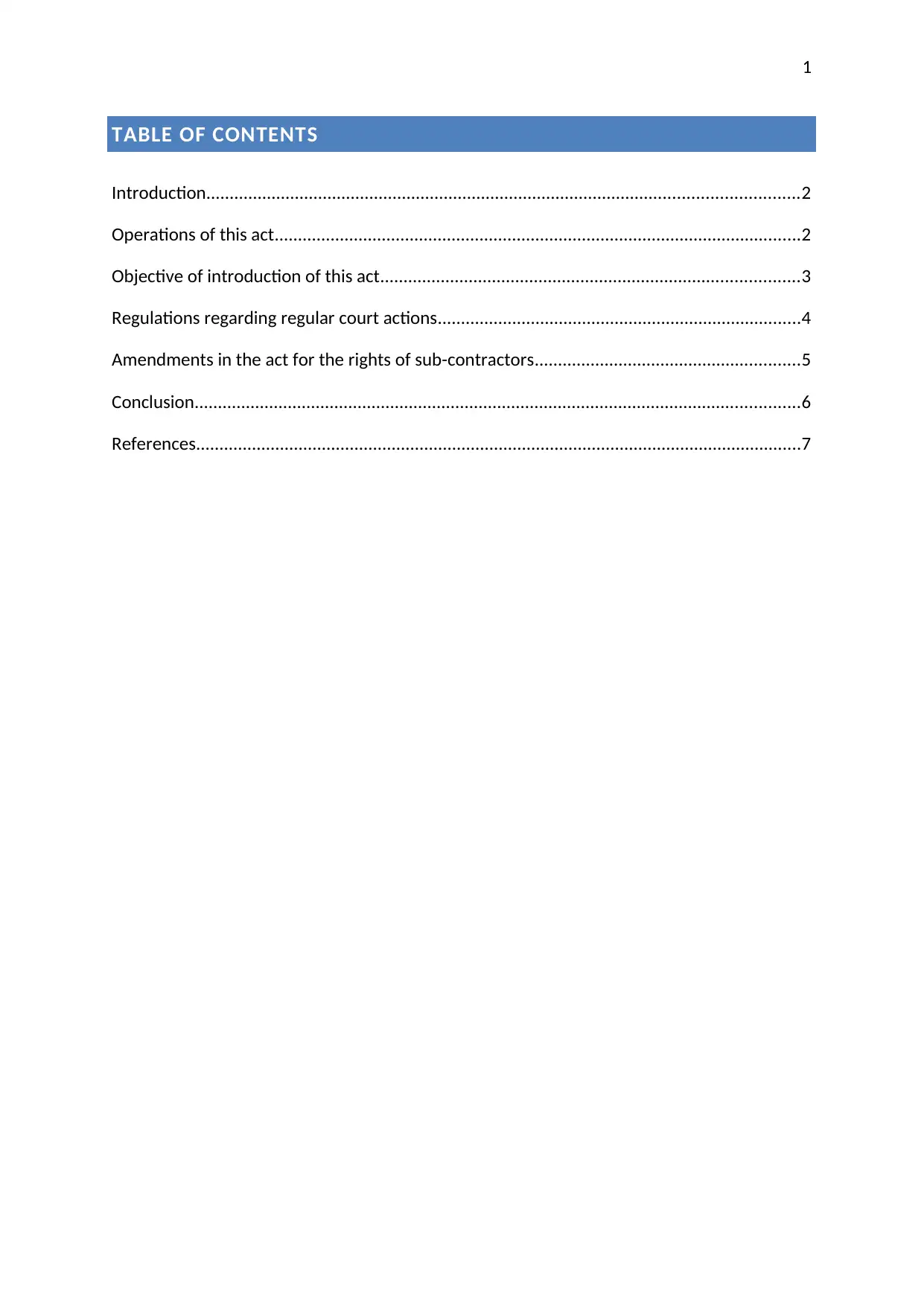
1
TABLE OF CONTENTS
Introduction...............................................................................................................................2
Operations of this act.................................................................................................................2
Objective of introduction of this act..........................................................................................3
Regulations regarding regular court actions..............................................................................4
Amendments in the act for the rights of sub-contractors.........................................................5
Conclusion..................................................................................................................................6
References..................................................................................................................................7
TABLE OF CONTENTS
Introduction...............................................................................................................................2
Operations of this act.................................................................................................................2
Objective of introduction of this act..........................................................................................3
Regulations regarding regular court actions..............................................................................4
Amendments in the act for the rights of sub-contractors.........................................................5
Conclusion..................................................................................................................................6
References..................................................................................................................................7
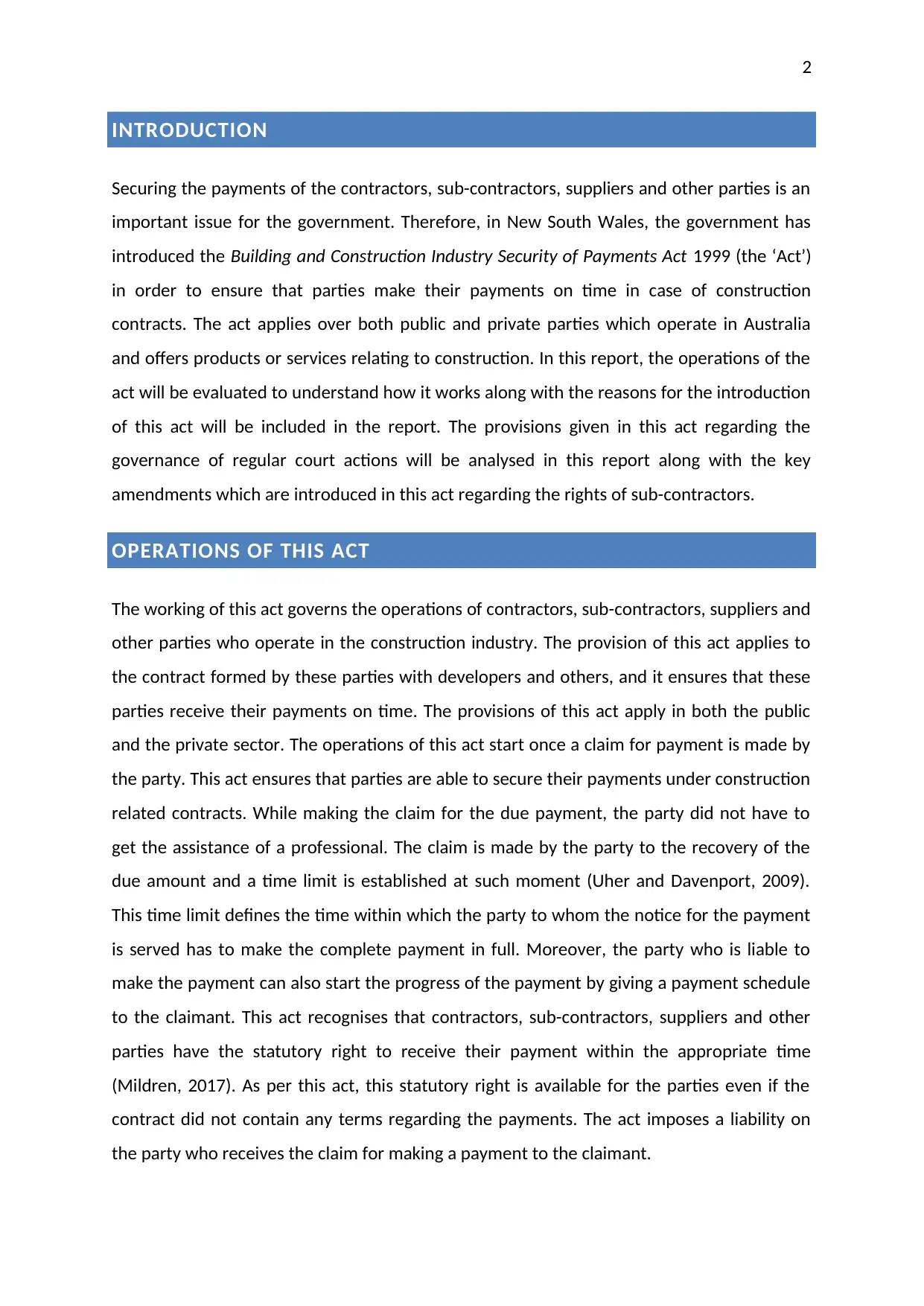
2
INTRODUCTION
Securing the payments of the contractors, sub-contractors, suppliers and other parties is an
important issue for the government. Therefore, in New South Wales, the government has
introduced the Building and Construction Industry Security of Payments Act 1999 (the ‘Act’)
in order to ensure that parties make their payments on time in case of construction
contracts. The act applies over both public and private parties which operate in Australia
and offers products or services relating to construction. In this report, the operations of the
act will be evaluated to understand how it works along with the reasons for the introduction
of this act will be included in the report. The provisions given in this act regarding the
governance of regular court actions will be analysed in this report along with the key
amendments which are introduced in this act regarding the rights of sub-contractors.
OPERATIONS OF THIS ACT
The working of this act governs the operations of contractors, sub-contractors, suppliers and
other parties who operate in the construction industry. The provision of this act applies to
the contract formed by these parties with developers and others, and it ensures that these
parties receive their payments on time. The provisions of this act apply in both the public
and the private sector. The operations of this act start once a claim for payment is made by
the party. This act ensures that parties are able to secure their payments under construction
related contracts. While making the claim for the due payment, the party did not have to
get the assistance of a professional. The claim is made by the party to the recovery of the
due amount and a time limit is established at such moment (Uher and Davenport, 2009).
This time limit defines the time within which the party to whom the notice for the payment
is served has to make the complete payment in full. Moreover, the party who is liable to
make the payment can also start the progress of the payment by giving a payment schedule
to the claimant. This act recognises that contractors, sub-contractors, suppliers and other
parties have the statutory right to receive their payment within the appropriate time
(Mildren, 2017). As per this act, this statutory right is available for the parties even if the
contract did not contain any terms regarding the payments. The act imposes a liability on
the party who receives the claim for making a payment to the claimant.
INTRODUCTION
Securing the payments of the contractors, sub-contractors, suppliers and other parties is an
important issue for the government. Therefore, in New South Wales, the government has
introduced the Building and Construction Industry Security of Payments Act 1999 (the ‘Act’)
in order to ensure that parties make their payments on time in case of construction
contracts. The act applies over both public and private parties which operate in Australia
and offers products or services relating to construction. In this report, the operations of the
act will be evaluated to understand how it works along with the reasons for the introduction
of this act will be included in the report. The provisions given in this act regarding the
governance of regular court actions will be analysed in this report along with the key
amendments which are introduced in this act regarding the rights of sub-contractors.
OPERATIONS OF THIS ACT
The working of this act governs the operations of contractors, sub-contractors, suppliers and
other parties who operate in the construction industry. The provision of this act applies to
the contract formed by these parties with developers and others, and it ensures that these
parties receive their payments on time. The provisions of this act apply in both the public
and the private sector. The operations of this act start once a claim for payment is made by
the party. This act ensures that parties are able to secure their payments under construction
related contracts. While making the claim for the due payment, the party did not have to
get the assistance of a professional. The claim is made by the party to the recovery of the
due amount and a time limit is established at such moment (Uher and Davenport, 2009).
This time limit defines the time within which the party to whom the notice for the payment
is served has to make the complete payment in full. Moreover, the party who is liable to
make the payment can also start the progress of the payment by giving a payment schedule
to the claimant. This act recognises that contractors, sub-contractors, suppliers and other
parties have the statutory right to receive their payment within the appropriate time
(Mildren, 2017). As per this act, this statutory right is available for the parties even if the
contract did not contain any terms regarding the payments. The act imposes a liability on
the party who receives the claim for making a payment to the claimant.
⊘ This is a preview!⊘
Do you want full access?
Subscribe today to unlock all pages.

Trusted by 1+ million students worldwide
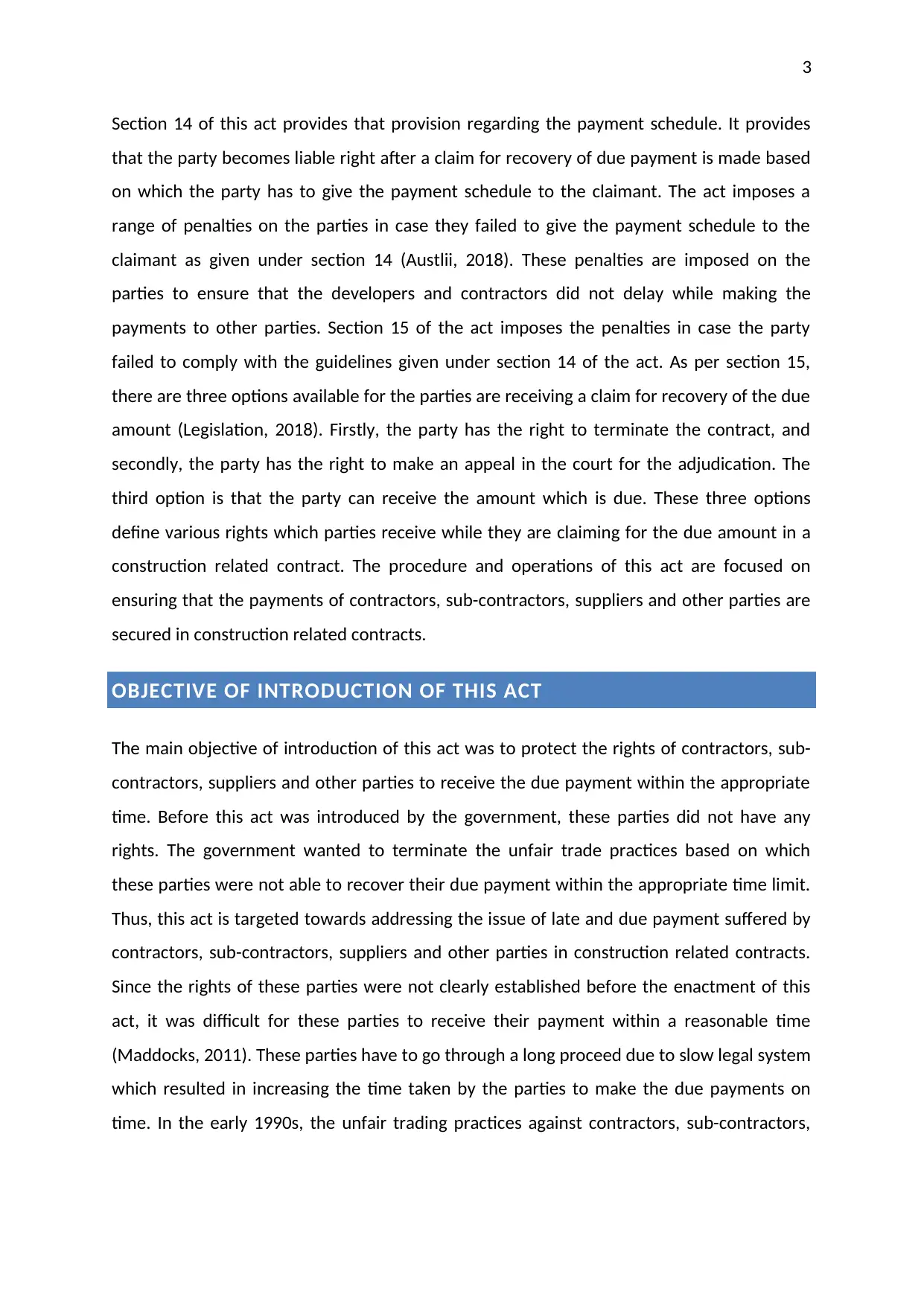
3
Section 14 of this act provides that provision regarding the payment schedule. It provides
that the party becomes liable right after a claim for recovery of due payment is made based
on which the party has to give the payment schedule to the claimant. The act imposes a
range of penalties on the parties in case they failed to give the payment schedule to the
claimant as given under section 14 (Austlii, 2018). These penalties are imposed on the
parties to ensure that the developers and contractors did not delay while making the
payments to other parties. Section 15 of the act imposes the penalties in case the party
failed to comply with the guidelines given under section 14 of the act. As per section 15,
there are three options available for the parties are receiving a claim for recovery of the due
amount (Legislation, 2018). Firstly, the party has the right to terminate the contract, and
secondly, the party has the right to make an appeal in the court for the adjudication. The
third option is that the party can receive the amount which is due. These three options
define various rights which parties receive while they are claiming for the due amount in a
construction related contract. The procedure and operations of this act are focused on
ensuring that the payments of contractors, sub-contractors, suppliers and other parties are
secured in construction related contracts.
OBJECTIVE OF INTRODUCTION OF THIS ACT
The main objective of introduction of this act was to protect the rights of contractors, sub-
contractors, suppliers and other parties to receive the due payment within the appropriate
time. Before this act was introduced by the government, these parties did not have any
rights. The government wanted to terminate the unfair trade practices based on which
these parties were not able to recover their due payment within the appropriate time limit.
Thus, this act is targeted towards addressing the issue of late and due payment suffered by
contractors, sub-contractors, suppliers and other parties in construction related contracts.
Since the rights of these parties were not clearly established before the enactment of this
act, it was difficult for these parties to receive their payment within a reasonable time
(Maddocks, 2011). These parties have to go through a long proceed due to slow legal system
which resulted in increasing the time taken by the parties to make the due payments on
time. In the early 1990s, the unfair trading practices against contractors, sub-contractors,
Section 14 of this act provides that provision regarding the payment schedule. It provides
that the party becomes liable right after a claim for recovery of due payment is made based
on which the party has to give the payment schedule to the claimant. The act imposes a
range of penalties on the parties in case they failed to give the payment schedule to the
claimant as given under section 14 (Austlii, 2018). These penalties are imposed on the
parties to ensure that the developers and contractors did not delay while making the
payments to other parties. Section 15 of the act imposes the penalties in case the party
failed to comply with the guidelines given under section 14 of the act. As per section 15,
there are three options available for the parties are receiving a claim for recovery of the due
amount (Legislation, 2018). Firstly, the party has the right to terminate the contract, and
secondly, the party has the right to make an appeal in the court for the adjudication. The
third option is that the party can receive the amount which is due. These three options
define various rights which parties receive while they are claiming for the due amount in a
construction related contract. The procedure and operations of this act are focused on
ensuring that the payments of contractors, sub-contractors, suppliers and other parties are
secured in construction related contracts.
OBJECTIVE OF INTRODUCTION OF THIS ACT
The main objective of introduction of this act was to protect the rights of contractors, sub-
contractors, suppliers and other parties to receive the due payment within the appropriate
time. Before this act was introduced by the government, these parties did not have any
rights. The government wanted to terminate the unfair trade practices based on which
these parties were not able to recover their due payment within the appropriate time limit.
Thus, this act is targeted towards addressing the issue of late and due payment suffered by
contractors, sub-contractors, suppliers and other parties in construction related contracts.
Since the rights of these parties were not clearly established before the enactment of this
act, it was difficult for these parties to receive their payment within a reasonable time
(Maddocks, 2011). These parties have to go through a long proceed due to slow legal system
which resulted in increasing the time taken by the parties to make the due payments on
time. In the early 1990s, the unfair trading practices against contractors, sub-contractors,
Paraphrase This Document
Need a fresh take? Get an instant paraphrase of this document with our AI Paraphraser
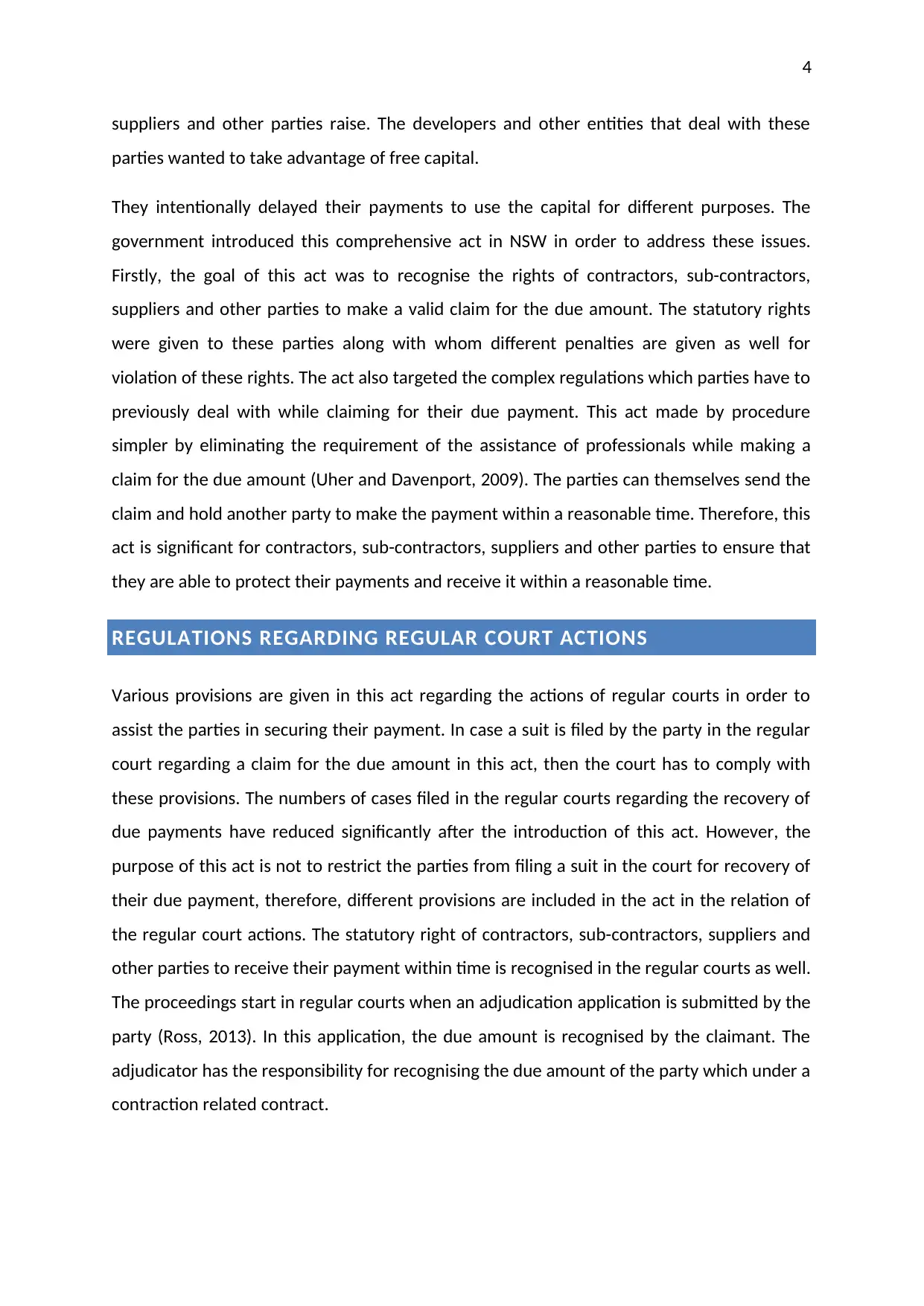
4
suppliers and other parties raise. The developers and other entities that deal with these
parties wanted to take advantage of free capital.
They intentionally delayed their payments to use the capital for different purposes. The
government introduced this comprehensive act in NSW in order to address these issues.
Firstly, the goal of this act was to recognise the rights of contractors, sub-contractors,
suppliers and other parties to make a valid claim for the due amount. The statutory rights
were given to these parties along with whom different penalties are given as well for
violation of these rights. The act also targeted the complex regulations which parties have to
previously deal with while claiming for their due payment. This act made by procedure
simpler by eliminating the requirement of the assistance of professionals while making a
claim for the due amount (Uher and Davenport, 2009). The parties can themselves send the
claim and hold another party to make the payment within a reasonable time. Therefore, this
act is significant for contractors, sub-contractors, suppliers and other parties to ensure that
they are able to protect their payments and receive it within a reasonable time.
REGULATIONS REGARDING REGULAR COURT ACTIONS
Various provisions are given in this act regarding the actions of regular courts in order to
assist the parties in securing their payment. In case a suit is filed by the party in the regular
court regarding a claim for the due amount in this act, then the court has to comply with
these provisions. The numbers of cases filed in the regular courts regarding the recovery of
due payments have reduced significantly after the introduction of this act. However, the
purpose of this act is not to restrict the parties from filing a suit in the court for recovery of
their due payment, therefore, different provisions are included in the act in the relation of
the regular court actions. The statutory right of contractors, sub-contractors, suppliers and
other parties to receive their payment within time is recognised in the regular courts as well.
The proceedings start in regular courts when an adjudication application is submitted by the
party (Ross, 2013). In this application, the due amount is recognised by the claimant. The
adjudicator has the responsibility for recognising the due amount of the party which under a
contraction related contract.
suppliers and other parties raise. The developers and other entities that deal with these
parties wanted to take advantage of free capital.
They intentionally delayed their payments to use the capital for different purposes. The
government introduced this comprehensive act in NSW in order to address these issues.
Firstly, the goal of this act was to recognise the rights of contractors, sub-contractors,
suppliers and other parties to make a valid claim for the due amount. The statutory rights
were given to these parties along with whom different penalties are given as well for
violation of these rights. The act also targeted the complex regulations which parties have to
previously deal with while claiming for their due payment. This act made by procedure
simpler by eliminating the requirement of the assistance of professionals while making a
claim for the due amount (Uher and Davenport, 2009). The parties can themselves send the
claim and hold another party to make the payment within a reasonable time. Therefore, this
act is significant for contractors, sub-contractors, suppliers and other parties to ensure that
they are able to protect their payments and receive it within a reasonable time.
REGULATIONS REGARDING REGULAR COURT ACTIONS
Various provisions are given in this act regarding the actions of regular courts in order to
assist the parties in securing their payment. In case a suit is filed by the party in the regular
court regarding a claim for the due amount in this act, then the court has to comply with
these provisions. The numbers of cases filed in the regular courts regarding the recovery of
due payments have reduced significantly after the introduction of this act. However, the
purpose of this act is not to restrict the parties from filing a suit in the court for recovery of
their due payment, therefore, different provisions are included in the act in the relation of
the regular court actions. The statutory right of contractors, sub-contractors, suppliers and
other parties to receive their payment within time is recognised in the regular courts as well.
The proceedings start in regular courts when an adjudication application is submitted by the
party (Ross, 2013). In this application, the due amount is recognised by the claimant. The
adjudicator has the responsibility for recognising the due amount of the party which under a
contraction related contract.
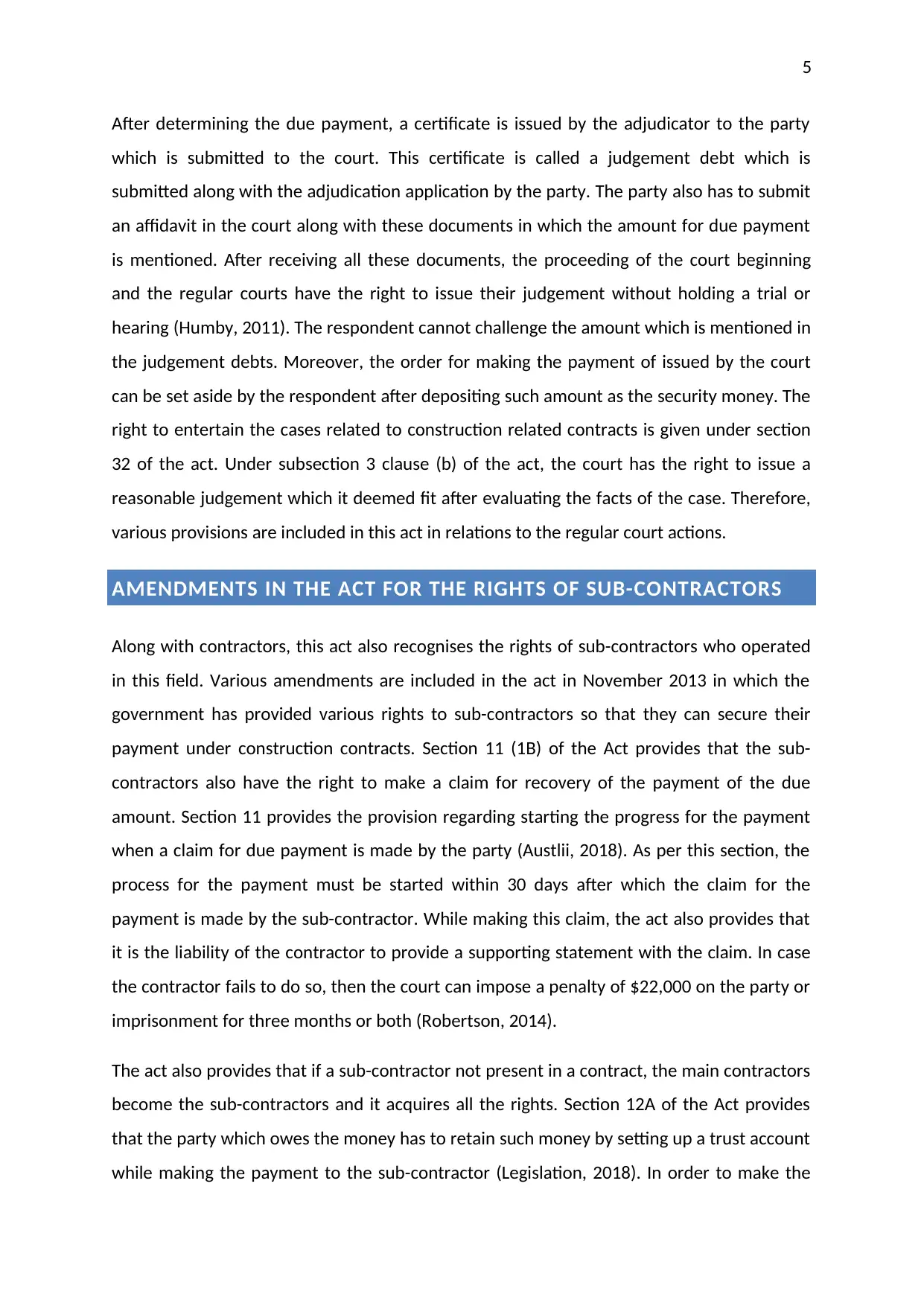
5
After determining the due payment, a certificate is issued by the adjudicator to the party
which is submitted to the court. This certificate is called a judgement debt which is
submitted along with the adjudication application by the party. The party also has to submit
an affidavit in the court along with these documents in which the amount for due payment
is mentioned. After receiving all these documents, the proceeding of the court beginning
and the regular courts have the right to issue their judgement without holding a trial or
hearing (Humby, 2011). The respondent cannot challenge the amount which is mentioned in
the judgement debts. Moreover, the order for making the payment of issued by the court
can be set aside by the respondent after depositing such amount as the security money. The
right to entertain the cases related to construction related contracts is given under section
32 of the act. Under subsection 3 clause (b) of the act, the court has the right to issue a
reasonable judgement which it deemed fit after evaluating the facts of the case. Therefore,
various provisions are included in this act in relations to the regular court actions.
AMENDMENTS IN THE ACT FOR THE RIGHTS OF SUB-CONTRACTORS
Along with contractors, this act also recognises the rights of sub-contractors who operated
in this field. Various amendments are included in the act in November 2013 in which the
government has provided various rights to sub-contractors so that they can secure their
payment under construction contracts. Section 11 (1B) of the Act provides that the sub-
contractors also have the right to make a claim for recovery of the payment of the due
amount. Section 11 provides the provision regarding starting the progress for the payment
when a claim for due payment is made by the party (Austlii, 2018). As per this section, the
process for the payment must be started within 30 days after which the claim for the
payment is made by the sub-contractor. While making this claim, the act also provides that
it is the liability of the contractor to provide a supporting statement with the claim. In case
the contractor fails to do so, then the court can impose a penalty of $22,000 on the party or
imprisonment for three months or both (Robertson, 2014).
The act also provides that if a sub-contractor not present in a contract, the main contractors
become the sub-contractors and it acquires all the rights. Section 12A of the Act provides
that the party which owes the money has to retain such money by setting up a trust account
while making the payment to the sub-contractor (Legislation, 2018). In order to make the
After determining the due payment, a certificate is issued by the adjudicator to the party
which is submitted to the court. This certificate is called a judgement debt which is
submitted along with the adjudication application by the party. The party also has to submit
an affidavit in the court along with these documents in which the amount for due payment
is mentioned. After receiving all these documents, the proceeding of the court beginning
and the regular courts have the right to issue their judgement without holding a trial or
hearing (Humby, 2011). The respondent cannot challenge the amount which is mentioned in
the judgement debts. Moreover, the order for making the payment of issued by the court
can be set aside by the respondent after depositing such amount as the security money. The
right to entertain the cases related to construction related contracts is given under section
32 of the act. Under subsection 3 clause (b) of the act, the court has the right to issue a
reasonable judgement which it deemed fit after evaluating the facts of the case. Therefore,
various provisions are included in this act in relations to the regular court actions.
AMENDMENTS IN THE ACT FOR THE RIGHTS OF SUB-CONTRACTORS
Along with contractors, this act also recognises the rights of sub-contractors who operated
in this field. Various amendments are included in the act in November 2013 in which the
government has provided various rights to sub-contractors so that they can secure their
payment under construction contracts. Section 11 (1B) of the Act provides that the sub-
contractors also have the right to make a claim for recovery of the payment of the due
amount. Section 11 provides the provision regarding starting the progress for the payment
when a claim for due payment is made by the party (Austlii, 2018). As per this section, the
process for the payment must be started within 30 days after which the claim for the
payment is made by the sub-contractor. While making this claim, the act also provides that
it is the liability of the contractor to provide a supporting statement with the claim. In case
the contractor fails to do so, then the court can impose a penalty of $22,000 on the party or
imprisonment for three months or both (Robertson, 2014).
The act also provides that if a sub-contractor not present in a contract, the main contractors
become the sub-contractors and it acquires all the rights. Section 12A of the Act provides
that the party which owes the money has to retain such money by setting up a trust account
while making the payment to the sub-contractor (Legislation, 2018). In order to make the
⊘ This is a preview!⊘
Do you want full access?
Subscribe today to unlock all pages.

Trusted by 1+ million students worldwide
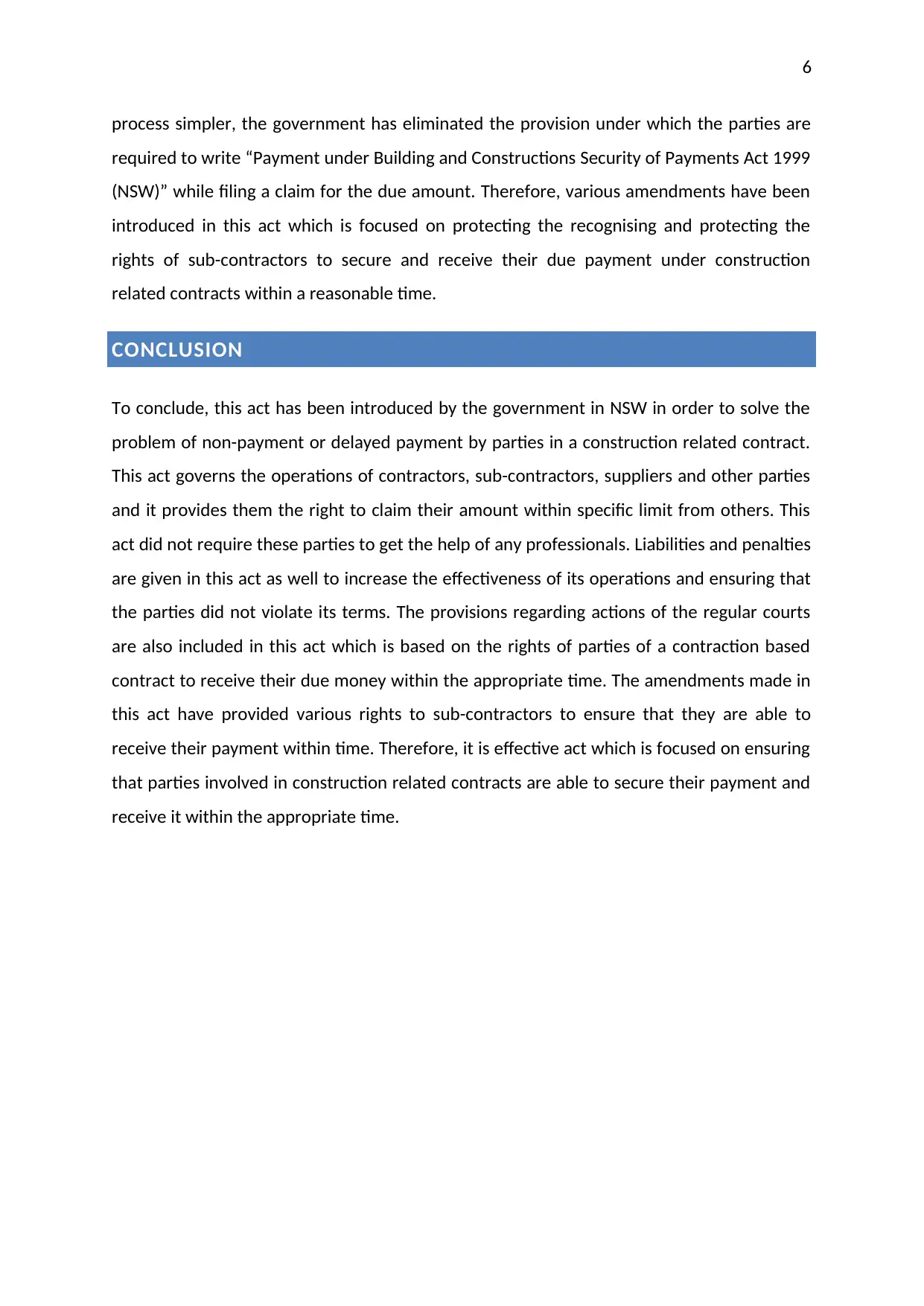
6
process simpler, the government has eliminated the provision under which the parties are
required to write “Payment under Building and Constructions Security of Payments Act 1999
(NSW)” while filing a claim for the due amount. Therefore, various amendments have been
introduced in this act which is focused on protecting the recognising and protecting the
rights of sub-contractors to secure and receive their due payment under construction
related contracts within a reasonable time.
CONCLUSION
To conclude, this act has been introduced by the government in NSW in order to solve the
problem of non-payment or delayed payment by parties in a construction related contract.
This act governs the operations of contractors, sub-contractors, suppliers and other parties
and it provides them the right to claim their amount within specific limit from others. This
act did not require these parties to get the help of any professionals. Liabilities and penalties
are given in this act as well to increase the effectiveness of its operations and ensuring that
the parties did not violate its terms. The provisions regarding actions of the regular courts
are also included in this act which is based on the rights of parties of a contraction based
contract to receive their due money within the appropriate time. The amendments made in
this act have provided various rights to sub-contractors to ensure that they are able to
receive their payment within time. Therefore, it is effective act which is focused on ensuring
that parties involved in construction related contracts are able to secure their payment and
receive it within the appropriate time.
process simpler, the government has eliminated the provision under which the parties are
required to write “Payment under Building and Constructions Security of Payments Act 1999
(NSW)” while filing a claim for the due amount. Therefore, various amendments have been
introduced in this act which is focused on protecting the recognising and protecting the
rights of sub-contractors to secure and receive their due payment under construction
related contracts within a reasonable time.
CONCLUSION
To conclude, this act has been introduced by the government in NSW in order to solve the
problem of non-payment or delayed payment by parties in a construction related contract.
This act governs the operations of contractors, sub-contractors, suppliers and other parties
and it provides them the right to claim their amount within specific limit from others. This
act did not require these parties to get the help of any professionals. Liabilities and penalties
are given in this act as well to increase the effectiveness of its operations and ensuring that
the parties did not violate its terms. The provisions regarding actions of the regular courts
are also included in this act which is based on the rights of parties of a contraction based
contract to receive their due money within the appropriate time. The amendments made in
this act have provided various rights to sub-contractors to ensure that they are able to
receive their payment within time. Therefore, it is effective act which is focused on ensuring
that parties involved in construction related contracts are able to secure their payment and
receive it within the appropriate time.
Paraphrase This Document
Need a fresh take? Get an instant paraphrase of this document with our AI Paraphraser
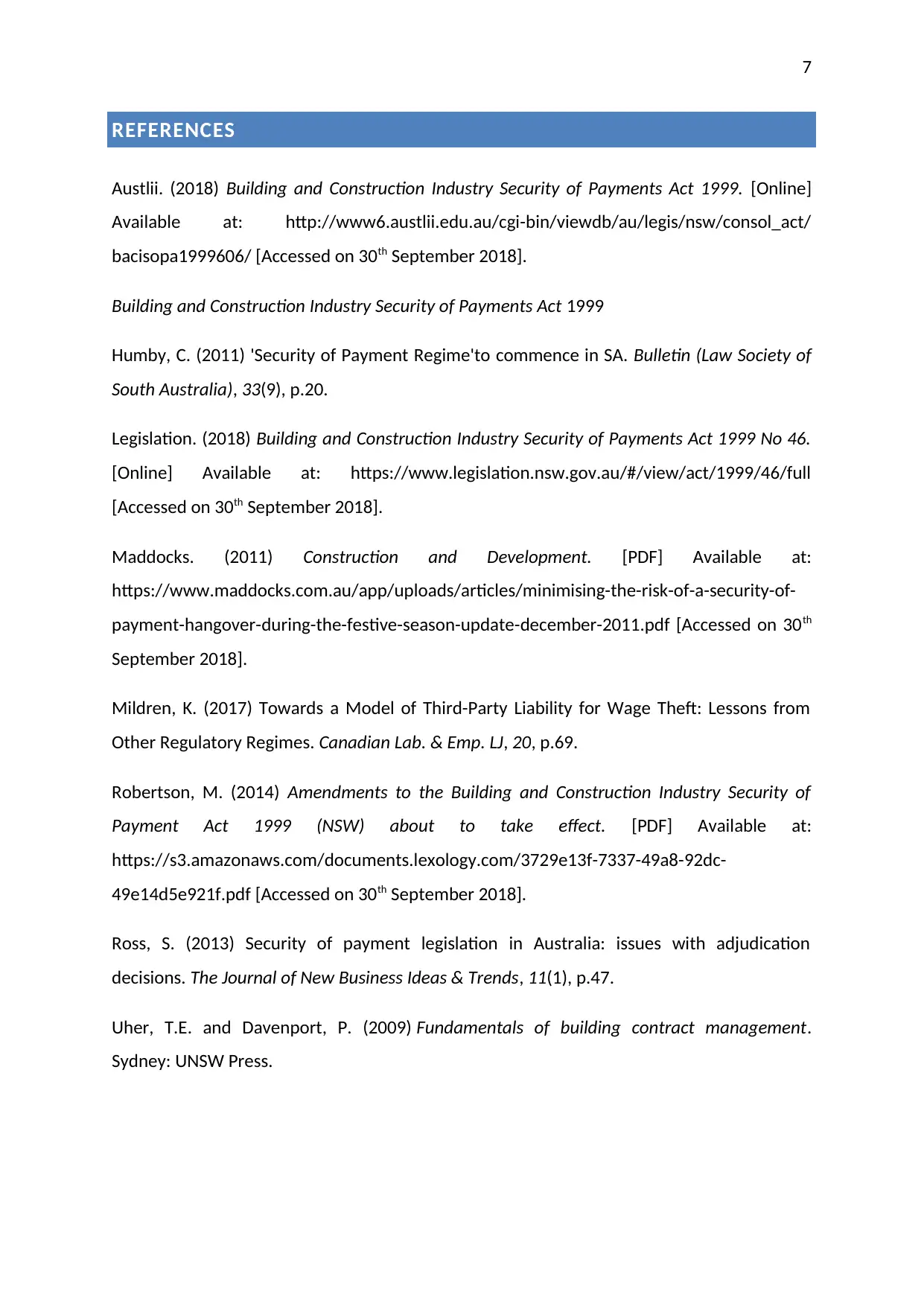
7
REFERENCES
Austlii. (2018) Building and Construction Industry Security of Payments Act 1999. [Online]
Available at: http://www6.austlii.edu.au/cgi-bin/viewdb/au/legis/nsw/consol_act/
bacisopa1999606/ [Accessed on 30th September 2018].
Building and Construction Industry Security of Payments Act 1999
Humby, C. (2011) 'Security of Payment Regime'to commence in SA. Bulletin (Law Society of
South Australia), 33(9), p.20.
Legislation. (2018) Building and Construction Industry Security of Payments Act 1999 No 46.
[Online] Available at: https://www.legislation.nsw.gov.au/#/view/act/1999/46/full
[Accessed on 30th September 2018].
Maddocks. (2011) Construction and Development. [PDF] Available at:
https://www.maddocks.com.au/app/uploads/articles/minimising-the-risk-of-a-security-of-
payment-hangover-during-the-festive-season-update-december-2011.pdf [Accessed on 30th
September 2018].
Mildren, K. (2017) Towards a Model of Third-Party Liability for Wage Theft: Lessons from
Other Regulatory Regimes. Canadian Lab. & Emp. LJ, 20, p.69.
Robertson, M. (2014) Amendments to the Building and Construction Industry Security of
Payment Act 1999 (NSW) about to take effect. [PDF] Available at:
https://s3.amazonaws.com/documents.lexology.com/3729e13f-7337-49a8-92dc-
49e14d5e921f.pdf [Accessed on 30th September 2018].
Ross, S. (2013) Security of payment legislation in Australia: issues with adjudication
decisions. The Journal of New Business Ideas & Trends, 11(1), p.47.
Uher, T.E. and Davenport, P. (2009) Fundamentals of building contract management.
Sydney: UNSW Press.
REFERENCES
Austlii. (2018) Building and Construction Industry Security of Payments Act 1999. [Online]
Available at: http://www6.austlii.edu.au/cgi-bin/viewdb/au/legis/nsw/consol_act/
bacisopa1999606/ [Accessed on 30th September 2018].
Building and Construction Industry Security of Payments Act 1999
Humby, C. (2011) 'Security of Payment Regime'to commence in SA. Bulletin (Law Society of
South Australia), 33(9), p.20.
Legislation. (2018) Building and Construction Industry Security of Payments Act 1999 No 46.
[Online] Available at: https://www.legislation.nsw.gov.au/#/view/act/1999/46/full
[Accessed on 30th September 2018].
Maddocks. (2011) Construction and Development. [PDF] Available at:
https://www.maddocks.com.au/app/uploads/articles/minimising-the-risk-of-a-security-of-
payment-hangover-during-the-festive-season-update-december-2011.pdf [Accessed on 30th
September 2018].
Mildren, K. (2017) Towards a Model of Third-Party Liability for Wage Theft: Lessons from
Other Regulatory Regimes. Canadian Lab. & Emp. LJ, 20, p.69.
Robertson, M. (2014) Amendments to the Building and Construction Industry Security of
Payment Act 1999 (NSW) about to take effect. [PDF] Available at:
https://s3.amazonaws.com/documents.lexology.com/3729e13f-7337-49a8-92dc-
49e14d5e921f.pdf [Accessed on 30th September 2018].
Ross, S. (2013) Security of payment legislation in Australia: issues with adjudication
decisions. The Journal of New Business Ideas & Trends, 11(1), p.47.
Uher, T.E. and Davenport, P. (2009) Fundamentals of building contract management.
Sydney: UNSW Press.
1 out of 8